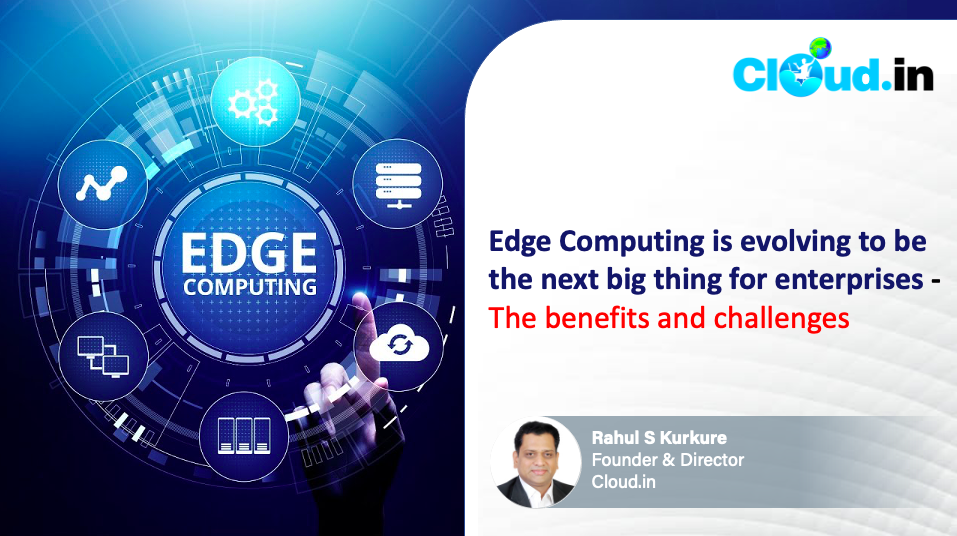Edge Computing is evolving to be the next big thing for enterprises – the benefits and challenges - Rahul S Kurkure, Founder & Director, Cloud.in

We have witnessed how the industry has evolved over the years, with
several developments such as Cloud, AI, IoT, and 5G, among many others. Cloud, with its advantages over traditional
on-premise infrastructure, has been playing a key role in the digital
transformation trends.
Today, along with the Cloud, another category of computing, that is edge computing is gaining traction. In this new distributed computing model, the processing and storing of data is close to where it is generated or created, or “at the edge”. The IT or DevOps teams can process data at the edge of the network instead of in the cloud or data warehouse or data center. Edge computing though is still in its infancy stage and not yet ready for mainstream adoption and become ubiquitous as cloud computing. However, the promise of edge computing is already seen in its delivery across many industrial applications, such as agriculture, healthcare, autonomous vehicles, and smart energy grids among many others. Low latency due to faster response times and the capability of quick action on real-time events are made possible with this new technology. The higher computing power at the edge enables organizations to increase efficiency and productivity leaving the manpower to focus on activities of higher value.
Factors driving the growth of Edge Computing
The increasing number of IoT devices will continue to grow further in
the coming years. The business-critical
applications in these IoT environments demand real-time data. Here, leveraging the computing infrastructure
– physical or virtual is done at the edge of the network. The network bandwidth
is minimized to access IoT data, without having to send it back to the cloud or
data center. Both IoT and edge computing
are powerful methods to analyze data to drive better business decisions in real
time.
When data transfer occurs between the cloud and devices, it is subjected to security risks. With edge computing, this risk can be reduced significantly. With improved security and compliance features, this is a preferred technology among IT teams. Edge platform also enables organizations to make use of modern devices without letting go of legacy systems, thereby helping to close modernization gaps.
Business benefits of edge computing are many
With the rapid growth of IoT devices and connected endpoint devices,
there is an increase in the data created at the edge of networks. Moreover, edge computing brings numerous
benefits to organizations. Due to the
decrease in travel time, the entire process is much faster, as data need not
make a round trip to the data center or cloud and back. The improved speed and reduced latency ensure
the proper functioning of endpoint devices especially those required for
critical applications, such as medical use cases, and autonomous vehicles. Security is at the forefront as data is
stored and protected on-site which is considered the best practice. There is increased data privacy as Edge
Computing helps organizations address security concerns. The cost of moving data and connectivity
costs are on the rise, especially with the increase in the volume of data
today. Edge computing keeps these costs
in check with the round trip to be made by the data getting eliminated. As data is processed at the source, marketing
teams can leverage automation to respond quickly to customer queries. Data related to customer location and
previous history of interactions can be processed in real-time to deliver a
hyper-personalized experience as augmented reality and virtual reality
capabilities improve. Customer
experience also gets enhanced.
Communication channels such as satellite connections are not used in edge computing, so even during the times when these channels are down, work does not suffer or get delayed, making the technology more reliable. Organizations can continue to add edge devices as they expand their uses rather than leveraging more computing resources in a data center that is centrally located.
Edge Platforms are not free of challenges
Managing a highly distributed environment in edge computing is very
complex as it is equivalent to managing numerous smaller IT environments,
leading to additional operating costs.
If the edge is not protected, it can become an easy target for
cyberattacks.
Edge ecosystems, still in their infancy stages of development, compared
to the cloud, are not yet matured and the solutions available are
incomplete. Edge devices also lack the
power and resources that are needed for data-intensive workloads or advanced
analytics. Scaling complexities at the
edge also means the deployment of additional staff, security, data management
technologies, licensing, and monitoring of the usage of resources. Overprovisioning will lead to a further rise
in costs.
As edge platforms only process and analyze partial sets of data, this will lead to data-related issues that have to be addressed with additional investment in resources and time.
According to Reportlinker, the global edge computing market is expected
to reach USD 17.80 billion by 2026 from USD 4 billion in 2020 as it is accepted
as a technology innovation that can be adopted across industry verticals. More
importantly, the new-age digital-first organizations look for innovating
outside the data center more often.
Edge is also used as a strategic initiative where
businesses are leveraging the data generated at the edge locations to create
differentiation and are gaining the much-needed competitive edge. Edge is also considered the next significant
frontier in IT as it is set to develop upon earlier modernization efforts
driving the next level of innovation.



